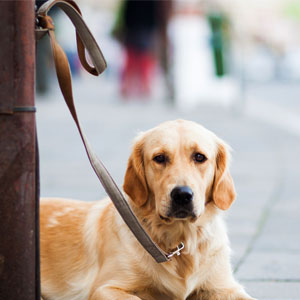
Tip #1: Have a Photo
Always keep current pictures of your pets! This is important to have, if ever your pet becomes lost and you need to make “Lost Pet” posters. This can also be helpful in proving that they belong to you if they become stolen.
Tip #2: Update Your Contact Information
Always check that you have a current phone number on your pet’s tag or in their digital profile that connects to a digital ID tag. In case of an emergency, it’s crucial that someone can contact you directly.
Tip #3: Check Leashes and Collars
Like everything else, leashes sometimes need to be replaced--especially if your pup thinks it’s a chew toy! Choose a quality leash that’s harder to damage like this one.
Check the latch regularly to be sure the spring is operating properly and examine the entire leash for any signs of damage. Check out dog collars on Chewy!
Tip #4: Add Identification On Your Pet
For ultimate protection make sure your pet has both external ID tags and is microchipped. For added protection go for digital ID tags for maximum protection!

Tip #5: Never Leave Your Dog Unattended Outside
It may be tempting to take your dog for a walk and get your errands done at the same time but don't do it if your errands require you to leave your dog outside while you enter the store. If you leave your dog unattended outside, you increase the risk of your dog getting stolen or escaping and getting lost.
Tip #6: Have a Plan For if You Lose Your Pet
This may sound broad but sit down and a make a list of things you might need if your pet gets lost. Some people even keep a lost pet recovery kit. This especially important if you know you have a pet who’s a flight risk.
Tip#7: Always Keep Your Pet’s Current Medical Records Available
This could be crucial in case of an emergency. High-tech ID tags, such as those powered by PetHub, link to an online profile for your pet and store critical medical information that is easy to access.
Tip #8: Keep Extra Pet Food On Hand
This could be helpful especially helpful if you live in an area prone to natural disasters, or even the occasional snow day, or simple power outage.
Tip #9: Keep Extra Collars and Leashes On Hand
This is helpful in the event a frightened pet get out of the one they’re wearing or if you happen to find a lost pet.
Tip #10: Beware of Flight Risk
Some dogs can be very fearful of new environments and some dogs--regardless of their environment--are just natural bolters.
Tip #11: Make Sure Your Pet's External Identification is Readable and Up to Date
Do a monthly check to make sure tags are still legible. If you are using a PetHub tag, check to make sure the QR is still scannable and the URL and hotline number are still legible.
Make a mental note to update your pet’s external identification any time your information changes such as your phone number. This may mean buying a traditional tag from the store or simply editing your account information for free on PetHub.com.
Tip #12: Always Keep An Extra Cell Phone Charger or Battery Handy
This is important in case of any emergency and especially in the case of a lost pet.
Tip #13: Get Pet Insurance!
Vet visits can be just as expensive as human doctor visits, which is why so many people invest in human health insurance. Anyone who has ever made an emergency vet visit especially knows how costly these trips can get.
Pet Insurance is a VERY affordable option for helping to alleviate the financial stress of emergencies. And best of all, many plans will cover free annual checkups! Want to learn more about different insurance options, what they cover, and the cost? Check out our instant comparison tool!
Tip #14: Get a Guide to Pet First Aid and Keep a First Aid Kit Readily Available
Keeping a first aid kit is essential for human and animals in the event of an accident. To learn more pet first-aid or where to purchase a pet first aid guide visit our friends at KURGO. (By the way, people and pets can use the same kits)
Tip #15: Go High Tech for Extra Protection.
Go High Tech for extra protection.High-tech tags, such as PetHub’s QR Digital Dog & Cat ID Tags, have a QR code or an NFC chip embedded in the tag that when scanned by any smartphone displays your contact information, as well as critical pet data, such as your pet’s license and rabies ID.
This information will allow animal control or a Good Samaritan who finds your pet to contact you, reuniting pet and owner fast.
Tip #16: Keep a List of Local Shelters, Veterinary Clinics and Rescue Organizations in Your Area
Keep one copy somewhere easy to find in your home and put a copy in the glove box of your car. This will come in handy not only if you lose a pet but also if you find a lost pet.
Tip #17: License Your Pet
It’s the law. If they ever become lost or stolen, this is an added level of protection.
Tip #18: Spay or Neuter Your Pet
Animals that haven’t been spayed or neutered are more likely to run away, due to their biological instincts.
Tip #19: Make Sure You Have a Collar That Fits Correctly
If your dog is a Houdini, use a harness. For cats, consider a breakaway collar.
A microchip, in addition to a collar ID tag is also important so there is a way to find your information if the collar comes off.
Tip #20: Prepare For the Case That You End Up Incapacitated
If you become ill or injured you may temporarily be incapable of taking care of your pet and reaching out to others to alert them about your pet.
Set a plan on how your pet will get taken care before the possibility of anything happening to you. PetHub’s wallet card can be a great tool to alert the one’s taking care of you about your pets and how to reach the people who can look after them.
Tip #22: Learn To Recognize When Your Pet is Showing Stress and Anxiety
Signs may include any or all of the following: panting, drooling, pacing, hiding, decreased appetite, abnormal urination or defecation, dilated pupils, and excessive grooming.
This behavior can be quelled with the help of training programs, check out your savings with Dunbar Academy and GoodPup through PetHub.
Tip #23: Always Have Extra Treats and Favorite Toys Available
Scrumptious treats like these could play a key role in finding a lost pet or luring a pet that’s run away from shock.
Tip #24: Keep a Small Pet Crate and Food In Your Car
You never know when a disaster could strike and you’ll need to pack up your furry family members quickly--or a neighbor could need help rallying up their pets.
You may also consider keeping this as part of a "Found Pet Kit", It's especially handy if you’re the kind of person who happens to be a magnet for finding lost pets.
Tip #25: Give Your Pet Obedience Training
Though, even the best-trained pets can still go missing, certain commands like “stay,” or knowing to come when called, can help.
Tip #26: Prepare For a Disaster
In the event of an earthquake, fire, or hurricane, no one would want to leave their pet behind. But, if that pet is hiding or you happen to be away when a disaster strikes, emergency rescue stickers are essential for alerting rescue workers that you have a trapped pet that needs help.
Tip #27: Microchip Your Pet
Microchipping, saves millions of lost pets from unfortunate euthanization each year. When an animal is brought in to a shelter, pound, veterinarian’s office, or animal emergency clinic, the first thing that’s done is to scan for a microchip.
Tip #28: Introduce Your New Adopted Dog to Their New Environment
Make sure you spend quality time introducing your new dog to the neighborhood. Walk them around so they get to know the area. Make sure your neighbors meet your dog, so if there is an escape, they know who to look for.
Tip #29: Houndini Proof Your Home
Make sure the inside of your home prevents your pet from escaping. Make sure windows are secure and that doors lock securely. Consider investing in baby gates and child proof latches If necessary.
Tip #30: Check Your Fence For Possible Escape Routes
A fence won't necessarily prevent your dog from escaping your yard. To look for ways to increase the security of your fence, monitor your dog's behavior. Is your dog a fence jumper, a digger, or both?
If your dog is a jumper you may need to increase the height of your fence and make sure no items are stacked up against the fence that can provide easy means of escape. If your dog is a digger, make sure the base of the periphery is secured. Sometimes a simple rock or boulder can block an area that a digger can get through.


